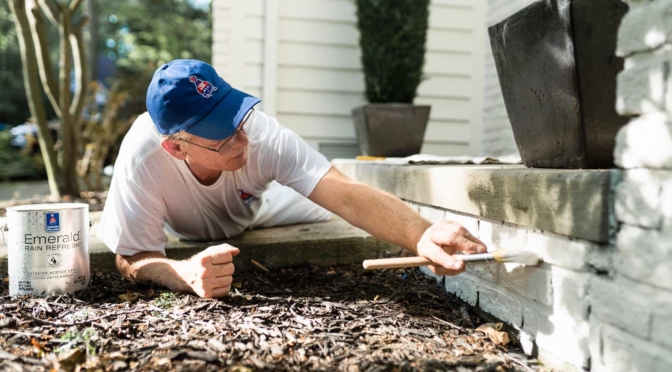Avoid blistering and peeling with these helpful tips
Brick can present unique challenges for professional painting contractors thanks to its unique properties as a substrate. Blistering, peeling, and the premature weathering of alkaline burn can all result from simple mistakes on the job site.
In this article, Dennis Fiorilli, Director of Product Excellence at Sherwin-Williams, shares a few helpful tips so you can paint brick with confidence and set your painting business apart from the competition.
Check the condition
Before you start painting, consider the condition of the brick you’ll be painting.
Be sure to check the pH level. All masonry substrates have some level of alkalinity or pH reading, but substrates with high pH levels require primers built to handle that. Improperly priming a high pH surface can result in alkaline burn, color change, and peeling and blistering.
There are a variety of methods you can use to test for pH, including pH pens, pencils, strips, and even digital tools. If you find that the pH is 10 or higher, you will want to make sure to use a specialized primer like Loxon® Concrete & Masonry Primer/Sealer.
“You’re looking for a primer that’s designed to be applied to concrete and masonry,” Fiorilli says. “Our Loxon® Concrete & Masonry Primer/Sealer is nice because it’s an interior/exterior primer, so whether you’re painting an indoor fireplace or an exterior brick wall, you can use the Loxon® primer there.”
Painters should also check how the substrate feels to the touch. If the brick has grit or a sandy texture that rubs off on your hands, you will want to use a conditioner to seal the substrate back into a paintable condition.
“Trying to paint on those surfaces will be like trying to paint on sand,” Fiorilli says. “When you put a topcoat over it, it might just peel off. For those cases, we do have Loxon® Acrylic Conditioner, which acts almost like a glue to seal it back into a sound surface that’s paintable.”
Fully dry the surface
While power washing can be a good and effective way to clean brick surfaces prior to painting, make sure to let the brick fully dry before painting. Fiorilli says this is a relatively common mistake.
“Even though the brick and mortar might look dry by sight or by touch, is it truly dry?” Fiorilli says. “If painters paint it too soon, moisture will be trapped underneath the topcoat. And when things warm up, moisture will want to escape through the coating, which can create issues like blistering and peeling.”
To prevent against this, use a moisture meter to take readings. Check in multiple locations, and make sure every reading is below a 15 percent threshold. You may be eager to start painting, but the time it takes to let the surface dry is less than the time it will take to repaint the whole surface.
Allocate enough paint
It’s easy to underestimate just how porous brick substrates can be. When painting brick surfaces, make sure to account for this so that you don’t run short on paint halfway through a job.
“Some painters underestimate the proper millage for brick,” Fiorilli says. “They’re looking to spread the products like they would if they’re painting a smoother-finish surface, but they’re not putting enough material on—and that applies to both primer and topcoat. Make sure you’re putting it on per specification, or it can create issues down the road.”
Not enough millage can result in a failure to fill properly or to protect against higher pH substrates, which can result in several of the same high-pH problems described earlier.
Back roll the topcoat
The topcoat process for brick is relatively flexible. One reason Fiorilli says he prefers Loxon® as a primer is because any exterior or interior topcoat can go over a Loxon® primer. Furthermore, Loxon®-based topcoats—such as Loxon® XP Waterproofing Masonry Coating—don’t require a specialized concrete or masonry primer.
While any topcoat will do if the surface has been properly primed, painters will want to make sure to apply the coat properly to avoid further issues.
“It’s usually easiest to spray when painting brick, so that you’re not constantly dipping and rolling,” Fiorilli says. “If you’re going to spray, though, we recommend back rolling it using a thick-nap roller to make sure that you’re pushing it into the pores of the brick substrate itself. That gives it a more even finish.”
Conclusion
While painting brick comes with certain difficulties, it’s nothing an informed and prepared crew can’t handle. Keeping these tips in mind will help ensure that you give your customer a flawless finish without the need for additional callbacks.

